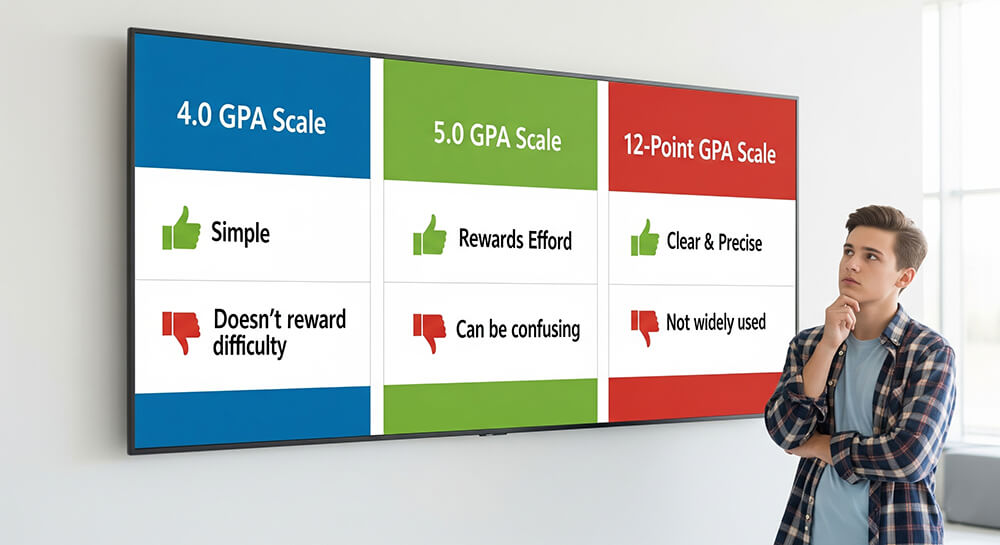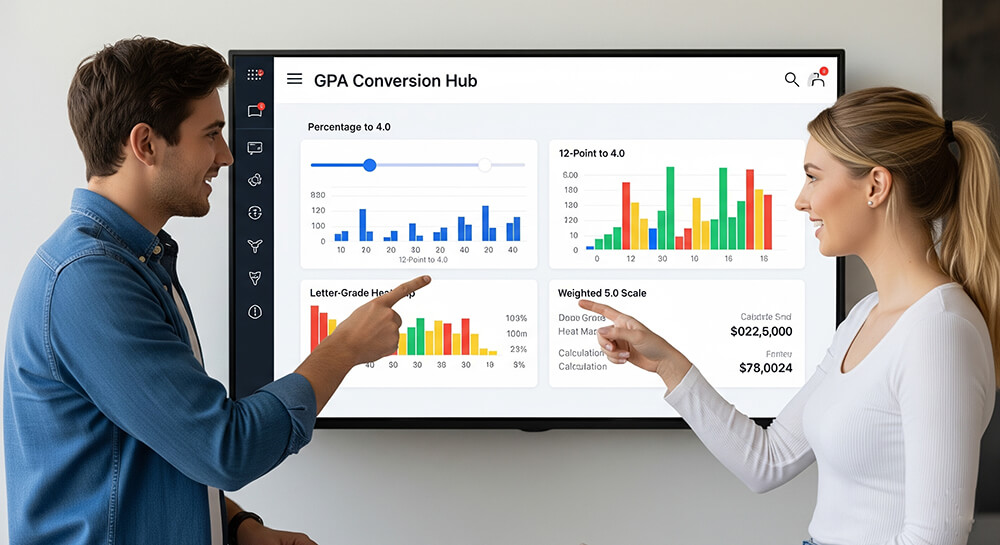Key Takeaways
| GPA Scale | Pros (The Good Parts) | Cons (The Not-So-Good Parts) |
|---|---|---|
| 4.0 Scale (Unweighted) | It is simple and easy to understand. Almost every school knows this system. It treats every class the same, which can feel fair. | It does not give extra credit for taking harder classes like AP or Honors. Your GPA cannot go above 4.0, even if you take the toughest courses. |
| 5.0 Scale (Weighted) | It rewards students for taking difficult classes. You can earn more than 4.0 points for an 'A' in an AP class. This helps top students stand out. | It can make GPAs seem higher than they are, which is sometimes called grade inflation. It can also be confusing to compare with the 4.0 scale. |
| 12-Point Scale | The points for each grade are very clear (e.g., A is 12, A- is 11). There are no tricky decimals. It often matches up well with percentage grades. | Not many schools in the U.S. use it, so it can be unfamiliar. You will likely need to convert it to a 4.0 scale for college applications. |
The Simple and Standard 4.0 GPA Scale (Unweighted)
The 4.0 GPA scale is the most common grading system. It is easy to understand because an 'A' is worth 4 points, a 'B' is 3 points, and so on. This scale is called "unweighted" because it does not matter if a class is easy or hard. An 'A' in gym class is worth the same as an 'A' in calculus. This makes it simple to figure out your average grade. Knowing the difference between a weighted vs. unweighted GPA is the first step. You can use a basic guide to learn how to calculate GPA with this system.
The Good and Bad of the 4.0 Scale
The best thing about the 4.0 scale is its simplicity. Everyone knows it. But it has a downside. It does not reward students for taking tougher classes. If you and a friend both get A's, but your class was much harder, you both get a 4.0. This can feel unfair. Also, the use of plus (+) and minus (-) grades can create weird gaps between points. For example, an A- might be a 3.7, while a B+ is a 3.3. This is why it's useful to understand the different types of GPA scales.
Rewarding Hard Work: The 5.0 GPA Scale (Weighted)
The 5.0 GPA scale was created to solve the main problem of the 4.0 scale. This "weighted" system gives extra points for harder classes. An 'A' in an AP or Honors class might be worth 5.0 points instead of 4.0. This encourages students to challenge themselves. A 5-0 GPA scale guide can show you exactly how the points are awarded. A GPA weighting guide for Honors and AP helps explain how these advanced courses can boost your overall average.
The Upside and Downside of the 5.0 Scale
The main benefit of the 5.0 scale is that it rewards effort. But it can also cause problems. One issue is GPA inflation vs. deflation, where grades might seem higher than they really are. This makes it tricky for colleges to compare students from different high schools. There are many weighted GPA myths debunked that students should read to understand the full picture. The complexity means you might need a special calculator to convert your grades.
A Clearer System: The 12-Point GPA Scale
The 12-point scale is another option, though it is less common in the United States. It is very clear because each grade level is one point apart. An A+ is 12 points, an A is 11, an A- is 10, and so on. This avoids the confusing decimals of the 4.0 scale. It can also be easier to do a percentage to 4-0 GPA conversion when starting from a 12-point system. A 12-point to 4-point scale chart is a vital tool for students who use this scale.
Strengths and Weaknesses of the 12-Point Scale
The biggest strength of the 12-point scale is its clarity. The one-point steps make sense and are easy to follow. However, its biggest weakness is that it is not widely used. Most colleges and scholarship committees are more familiar with the 4.0 scale. This means students often have to convert their grades. Understanding 12-point vs. 10-point GPA conversion can also be helpful for students looking at international schools, as the 10-point scale is common in other countries.
Comparing the Scales Side-by-Side
It can be confusing to switch between different GPA scales. That is why GPA conversion charts and tools are so important. They help you see what your grade is worth in another system. For example, a 4.5 on a weighted scale is not the same as a 4.0 on an unweighted scale. A 4-0 vs 5-0 GPA outcome simulator can show you how your grades would look on both scales. This helps you present your academic achievements accurately.
How to Choose the Right Scale for You
The GPA scale your school uses is usually not up to you. But understanding the pros and cons of each helps you know where you stand. You can use a GPA calculator to manage your grades no matter what system your school uses. A good college GPA calculator can help you stay on track toward your goals. Knowing how these scales work empowers you to make smart choices about your classes and your future.
Frequently Asked Questions (FAQ)
1. Which GPA scale is the best? There is no single "best" scale. The 4.0 scale is simple and widely understood. The 5.0 scale is better at rewarding students for taking hard classes. The 12-point scale is very clear and precise. The best one depends on what you want to measure.
2. Why would a school use a weighted GPA scale? A school uses a weighted GPA scale to encourage students to take more challenging courses, like AP or Honors. It gives them a GPA boost that recognizes their hard work.
3. Does a 4.0 on an unweighted scale look bad to colleges? No, a 4.0 on an unweighted scale is an excellent GPA. Colleges also look at your transcript to see the difficulty of the courses you took. They understand that a 4.0 at a school with no weighted classes is a top achievement.
4. Is the 12-point scale common in the US? No, the 12-point scale is not common in U.S. high schools or colleges. It is used more often in other countries, like Canada.
5. How can I compare my weighted GPA to a 4.0 scale? You can use an online GPA conversion tool or calculator. These tools will ask for your grades and whether your classes were weighted. They can then show you your equivalent GPA on the standard 4.0 scale.








